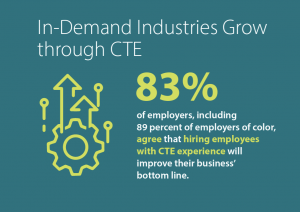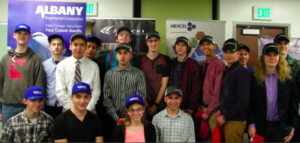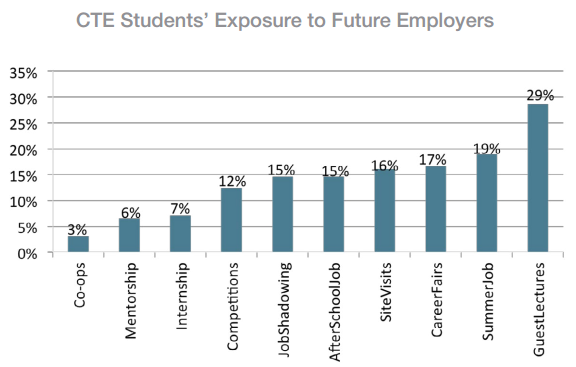 CareerSafe was founded in 2003 under the core belief that no job is worth a young worker’s life. CareerSafe has expanded their focus to include the whole worker. From safety and health training to employability skills and cybersecurity awareness, CareerSafe is focused on providing the foundational skills workers need to launch successful careers.
CareerSafe was founded in 2003 under the core belief that no job is worth a young worker’s life. CareerSafe has expanded their focus to include the whole worker. From safety and health training to employability skills and cybersecurity awareness, CareerSafe is focused on providing the foundational skills workers need to launch successful careers.
Starting with Safety
A first step of safety training can occur as soon as middle school or freshman year, with CareerSafe’s StartSafe program. A site-license specific training will provide five (5) hours of core content, as well as the opportunity to explore additional pathways. StartSafe is the perfect introduction to OSHA and workplace safety, covering topics such as:
- Personal Protective Equipment (PPE)
- Walking-Working Surfaces
- Bloodborne Pathogens
- Electrocution Hazards
- Workplace Violence
OSHA 10-Hour Training
The next obvious step in each learner’s safety training is OSHA 10-Hour Training in either General Industry or in Construction with several industry-specific pathways including:
- Healthcare
- Public Safety
- Agriculture
- Automotive
- Cosmetology
- Culinary
- Manufacturing
- Veterinary
OSHA 10-Hour training is purchase per seat and registered through the U.S. Department of Labor, granting each student a recognized OSHA General or Construction Industry card.
Cyber Safety Awareness
Technological advances have made the digital world an integral part of everyday life. Unfortunately, that means online risks for young people are also becoming more prevalent. The CareerSafe Cyber Safety Awareness Library contains courses with grade-level focused topics for 6th-12th grades and covers situations like cyberbullying, sexting, and the consequences of school threats. This is a site license program as well.
Employability Skills
The final step on preparing learners for workplace readiness is the CareerSafe library of Employability skills.
These courses are available per seat or by site license and they provide quality resources and techniques for building essential skills and strategies applicable in all professional fields. Topics include:
- Written communication
- Cybersecurity essentials for work
- Interview skills
- Critical thinking
- Communication skills
- Time management
- Teamwork
- Personal financial management
- Materials management
When you add in CareerSafe’s best-of-class customer service, innovative online curriculum, and effective teacher tools, there are numerous ways to educate your learners.
By offering the whole suite of CareerSafe products, from StartSafe to OSHA 10-hour training, cyber security training to employability skills, the result is a well-rounded, educated young worker who is capable of staying safe in the workplace.
Scaling Across Your State
CareerSafe believes that all students deserve the right to a safe and fair workplace. What better way to prepare your students to remain safe in the workplace than to equip them with the knowledge and understanding of OSHA safety training while still in high school. Because our courses easily integrate within your teacher’s existing CTE curriculum and are created to align with the National Career Clusters Framework this opportunity allows for states to scale this course across all pathways for every student. We have Account Executives available across the country to walk you through how to get set up today. Let us help you set your students on a path to success.
Sherry Pruitt, Executive Director of CareerSafe
Sherry.Pruitt@careersafeonline.com
888-614-7233


 Tell me more about your journey to the Fellowship.
Tell me more about your journey to the Fellowship.
 There has been an increasing push within the manufacturing industry to reshore more production back to the U.S. due to recent legislation at the federal and state levels. While there have been policies regarding federal purchasing that require domestic production, such as the Defense Federal Acquisition Regulation Supplement (DFARS), the Buy American Act and recently the Build America Buy America Act, there are now new policies being enacted focused on supporting private sector domestic sourcing. The Creating Helpful Incentives to Produce Semiconductors and Science Act of 2022 (CHIPS and Science ACT) is intended to increase more domestic production of semiconductors, but also to support the growth of new and emerging technologies such as quantum computing, AI, clean energy and nanotechnology. To facilitate this growth, the CHIPS Act authorizes $174 billion over the next five years for STEM programs, workforce development and research and development (R&D).
There has been an increasing push within the manufacturing industry to reshore more production back to the U.S. due to recent legislation at the federal and state levels. While there have been policies regarding federal purchasing that require domestic production, such as the Defense Federal Acquisition Regulation Supplement (DFARS), the Buy American Act and recently the Build America Buy America Act, there are now new policies being enacted focused on supporting private sector domestic sourcing. The Creating Helpful Incentives to Produce Semiconductors and Science Act of 2022 (CHIPS and Science ACT) is intended to increase more domestic production of semiconductors, but also to support the growth of new and emerging technologies such as quantum computing, AI, clean energy and nanotechnology. To facilitate this growth, the CHIPS Act authorizes $174 billion over the next five years for STEM programs, workforce development and research and development (R&D). To maximize’s CTE’s value in reshoring, employers must be informed on its alignment with reshoring-connected careers and be partners in designing CTE programs to meet skills needs. Advance CTE’s employer engagement
To maximize’s CTE’s value in reshoring, employers must be informed on its alignment with reshoring-connected careers and be partners in designing CTE programs to meet skills needs. Advance CTE’s employer engagement  October 7 was National Manufacturing Day but, in Ohio, the celebration lasts the entire month. . Ohio uses this time to raise awareness of the various manufacturing pathways available to learners in the state and inspire those learners to join. Ohio already has significant investments in the manufacturing economy which generates more than $125 billion. However, knowledge of how many different skill sets and jobs are available in the industry is still not widespread. By taking advantage of Manufacturers Month, this post highlights the innovative ways Ohio is uplifting the manufacturing pathway as well as leveraging the support of The Ohio Manufacturers’ Association (OMA), which is bringing awareness to various grants and programs, some of which have been made recently available to Ohio residents.
October 7 was National Manufacturing Day but, in Ohio, the celebration lasts the entire month. . Ohio uses this time to raise awareness of the various manufacturing pathways available to learners in the state and inspire those learners to join. Ohio already has significant investments in the manufacturing economy which generates more than $125 billion. However, knowledge of how many different skill sets and jobs are available in the industry is still not widespread. By taking advantage of Manufacturers Month, this post highlights the innovative ways Ohio is uplifting the manufacturing pathway as well as leveraging the support of The Ohio Manufacturers’ Association (OMA), which is bringing awareness to various grants and programs, some of which have been made recently available to Ohio residents.  In August, the OMA was named one of the 32 finalists for the “
In August, the OMA was named one of the 32 finalists for the “ In the next decade, job seekers in manufacturing will find plenty of openings. It’s projected that nearly 3.5 million manufacturing jobs will need to be filled in the next 10 years. The challenge, however, is that there aren’t enough qualified workers to fill the positions. An aging workforce, changing technologies, and misperceptions about the industry all contribute to the shortage. This has serious consequences for the manufacturing industry, which is overwhelmingly not prepared. In fact, nearly nine out of 10 manufacturers say that their company is having problems finding skilled workers in manufacturing.
In the next decade, job seekers in manufacturing will find plenty of openings. It’s projected that nearly 3.5 million manufacturing jobs will need to be filled in the next 10 years. The challenge, however, is that there aren’t enough qualified workers to fill the positions. An aging workforce, changing technologies, and misperceptions about the industry all contribute to the shortage. This has serious consequences for the manufacturing industry, which is overwhelmingly not prepared. In fact, nearly nine out of 10 manufacturers say that their company is having problems finding skilled workers in manufacturing.  We have compiled a list of highlights in Career Technical Education (CTE) from this week to share with you.
We have compiled a list of highlights in Career Technical Education (CTE) from this week to share with you.
 Today is Manufacturing Day® a celebration of modern manufacturing meant to inspire the next generation of manufacturers. This day, recognized annually on the first Friday in October, features events around the world to provide a behind-the-scenes look at a growing industry. Find an event near you
Today is Manufacturing Day® a celebration of modern manufacturing meant to inspire the next generation of manufacturers. This day, recognized annually on the first Friday in October, features events around the world to provide a behind-the-scenes look at a growing industry. Find an event near you This program of study was established in 2015, in response to industry demand for skilled employees in aerospace careers. In that same year, the Utah aerospace industry accounted for 944 companies.The Utah Governor’s Office of Economic Development, five local aerospace industry partners and secondary and postsecondary institutions, worked closely to develop the robust program to address this growing need for a skilled workforce. It is one of the four Utah Talent Ready Initiative programs, which aims to fill 40,000 new high-skill, high-wage jobs in Utah over the next four years.
This program of study was established in 2015, in response to industry demand for skilled employees in aerospace careers. In that same year, the Utah aerospace industry accounted for 944 companies.The Utah Governor’s Office of Economic Development, five local aerospace industry partners and secondary and postsecondary institutions, worked closely to develop the robust program to address this growing need for a skilled workforce. It is one of the four Utah Talent Ready Initiative programs, which aims to fill 40,000 new high-skill, high-wage jobs in Utah over the next four years.